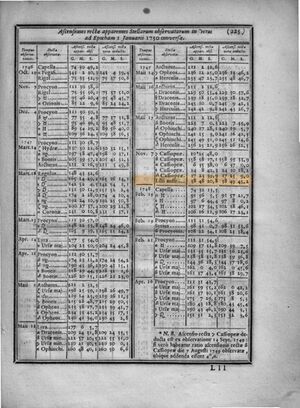Lilii Austrina: Difference between revisions
From All Skies Encyclopaedia
(two images added) |
No edit summary |
||
| (14 intermediate revisions by the same user not shown) | |||
| Line 1: | Line 1: | ||
[[File:Lacaille LiliiAustrina marked.jpg|alt=screenshot with highlighting|thumb|Lilii Austrina in Lacaille's star list 1757. in: "Astronomiae fundamenta novissimis solis et stellarum observationibus stabilita, Lutetiae in Collegio mazarineo et in Africa ad caput Bonae Spei peractis a Nicolao Ludovico de La Caille" ]] |
[[File:Lacaille LiliiAustrina marked.jpg|alt=screenshot with highlighting|thumb|Lilii Austrina in Lacaille's star list 1757. in: "Astronomiae fundamenta novissimis solis et stellarum observationibus stabilita, Lutetiae in Collegio mazarineo et in Africa ad caput Bonae Spei peractis a Nicolao Ludovico de La Caille" ]] |
||
In his short list of right ascensions of selected stars, Lacaille 1757 named this star "The one south of the Lily" in Latin: Lilii Austrina. |
In his short list of right ascensions of selected stars and his star catalogue, Lacaille 1757 named this star "The one south of the Lily" (or "the southern one of the Lily") in Latin: Lilii Austrina. This name was used specifically for the star 41 Ari that was officially named "Bharani" by the IAU in 2017, thus leaving no room for Lilii Austrina in the IAU name catalog. |
||
The Lily ([[Lilium]]) is an obsolete constellation of the 17th century. It was formed of four stars that were unnamed in antiquity: In the Almagest they were listed as "The 4 stars over the rump [of the Ram]", outside the constellation image. |
|||
#REDIRECT [[Lilii Borea]] |
|||
==Etymology and History== |
|||
[[File:Lilium Pardies, Ignace-Gaston (1636-1673). Cartographe bnf-gallica.jpg|alt=screenshot of map with highlighting of the Lily|thumb|Lilium in "Globi coelestis in tabulas planas redacti descriptio auctore R.P." by Ignatio Gastone Pardies Societatis Jesu mathematico opus postumum" by Ignace-Gaston Pardies (1636-1673), [https://gallica.bnf.fr/ark:/12148/btv1b59714416/f2.zoom digital]. ]] |
|||
Augustin Royer (1679) introduced a new (now obsolete) constellation Lilium (The Lily). The Lily was an emblem of France. In particular, in the time of Louis XIV this symbol was dedicated to the French king as the representative of the country. |
|||
==Mythology== |
|||
==IAU Working Group Star Names== |
|||
As "[[Lilii Borea]]" has been applied to 39 Ari in 2017, the IAU discusses the parallel name in 2023/4. |
|||
== Weblinks == |
|||
* Ridpath, Ian, ''[http://www.ianridpath.com/startales/muscaborealis.html#lilium Star Tales: Lilium, the fleur-de-lis]''. |
|||
== Reference == |
|||
Lacaille, N.L. de (1757) Astronomiae fundamenta novissimis Solis et stellarum observationibus stabilita Lutetiæ in collegio Mazarinæo et in Africa ad Caput Bonæ Spei peractis. p.233. |
|||
[[Category:Single star-asterism]] |
[[Category:Single star-asterism]] |
||
[[Category:Star Name]] |
|||
[[Category:Eurasia]] |
[[Category:Eurasia]] |
||
[[Category:European]] |
[[Category:European]] |
||
[[Category:Ari]] |
|||
Latest revision as of 18:45, 1 February 2025
In his short list of right ascensions of selected stars and his star catalogue, Lacaille 1757 named this star "The one south of the Lily" (or "the southern one of the Lily") in Latin: Lilii Austrina. This name was used specifically for the star 41 Ari that was officially named "Bharani" by the IAU in 2017, thus leaving no room for Lilii Austrina in the IAU name catalog.
The Lily (Lilium) is an obsolete constellation of the 17th century. It was formed of four stars that were unnamed in antiquity: In the Almagest they were listed as "The 4 stars over the rump [of the Ram]", outside the constellation image.
- REDIRECT Lilii Borea





